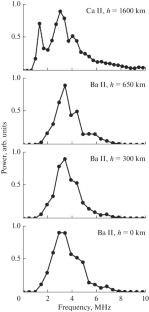太阳面和絮状流:FeⅠ、BaⅡ和CaⅡ谱线中的测谱和滤光观测结果
摘要
摘要 讨论了对位于太阳圆盘中心附近的一个面区在 Fe I 1564.3、Fe I 1565.8、Ba II 455.4 和 Ca II H 396.8 nm 线段进行的分光比容和滤光片观测的结果。观测数据是利用特内里费特德天文台(Observatorio del Teide,西班牙)的德国真空塔望远镜获得的。对面区的观测是在三个光谱区同时进行的:对两条中性铁线 Fe I 1564.8 和 Fe I 1565.2 nm 的 I、Q、U 和 V 斯多克斯参数进行分光测极法观测,时间分辨率为 6 分 50 秒;对电离钡 Ba II 455.4 nm 线的 37 个剖面进行滤波观测,时间分辨率为 6 分 50 秒。研究了以下观测数据:(1) 在 Fe I 1564.8 和 Fe I 1565.2 nm 附近形成连续光谱高度的磁场功率;(2) 在 Fe I 1564.8 和 Fe I 1565.2 nm 附近形成连续光谱高度的磁场功率;(3) 在 Fe I 1564.8 和 Fe I 1565.2 nm 附近形成连续光谱高度的磁场功率。8 和 Fe I 1565.2 nm 线附近形成连续光谱的高度处的磁场功率(h ≈ -100 km);(2)太阳大气中 14 个高度层的波速,在这 14 个高度层中,Ba II 455.4 nm 光谱线形成高度(h ≈ 0-650 km)的波速,以及计算出的该光谱线中心辐射形成高度(h ≈ 650 km)光球速度 V 波动与其他 13 个高度层速度波动之间的相移 Φ(V,V);以及 (3) Ca II H 396.8 nm 光谱线中心形成高度(h ≈ 1600 km)的面对比。显示了以下两个趋势:(1) 随着太阳大气层高度的变化,速度波动的功率随振荡频率的不同而变化很大。在 0 至 300 千米的高度范围内,最大振荡功率出现在 3.5 毫赫兹的频率上。另一个最大值出现在 h = 650 千米高度的 4.5 毫赫兹附近,而在 h = 1600 千米高度时,频率约为 1.5 毫赫兹的最大振荡功率非常明显。(2) Ca II H 396.8 nm 线中心(h = 650 千米)的对比度并不像一般预期的那样随着光球层磁场强度的增加而单调增加。在大磁场(B > 140 mT)下,这种依赖关系变成了反比。


The results of spectropolarimetric and filter observations of a faculae region located near the solar disc center in the Fe I 1564.3, Fe I 1565.8, Ba II 455.4, and Ca II H 396.8 nm lines are discussed. The observation data are obtained using the German vacuum tower telescope of Observatorio del Teide (Tenerife, Spain). Observations of the faculae region are made simultaneously in the three spectral regions: spectropolarimetric observations of the I, Q, U, and V Stokes parameters of two neutral iron lines Fe I 1564.8 and Fe I 1565.2 nm with a time resolution of 6 min 50 s; filter observations in 37 sections of the profile of the ionized barium Ba II 455.4 nm line with a time resolution of 25.6 s; and filter observations only in the center of the ionized calcium Ca II H 396.8 nm line with a time resolution of 4.9 s. The following observation data are studied: (1) the power of the magnetic field at the altitude of the formation of a continuous spectrum near the Fe I 1564.8 and Fe I 1565.2 nm lines (h ≈ −100 km); (2) wave velocities at fourteen altitude levels in the atmosphere of the Sun, at which radiation in the Ba II 455.4 nm spectral line is formed (h ≈ 0−650 km), and calculated phase shifts Φ(V,V) between fluctuations of velocity V in the photosphere at the height of radiation formation in the center of this line (h ≈ 650 km) and velocity fluctuations at the other thirteen altitude levels; and (3) the faculae contrast at the altitude of formation of the Ca II H 396.8 nm line center (h ≈ 1600 km). The following two trends are shown: (1) The power of velocity fluctuations greatly varies depending on the frequency of oscillations with a change in the altitude in the atmosphere of the Sun. At the altitudes ranging from 0 to 300 km, the maximum oscillation power occurs at a frequency of 3.5 mHz. Another maximum occurs near a frequency of 4.5 mHz at the altitude level of h = 650 km, and the maximum oscillation power at a frequency of approximately 1.5 mHz is quite noticeable at an altitude of h = 1600 km. (2) The contrast in the center of the Ca II H 396.8 nm line (h = 650 km) does not monotonically increase with an increase in the intensity of the photospheric magnetic field, as might be expected from general considerations. At large magnetic fields (B > 140 mT), this dependence becomes inverse.

 求助内容:
求助内容: 应助结果提醒方式:
应助结果提醒方式:


